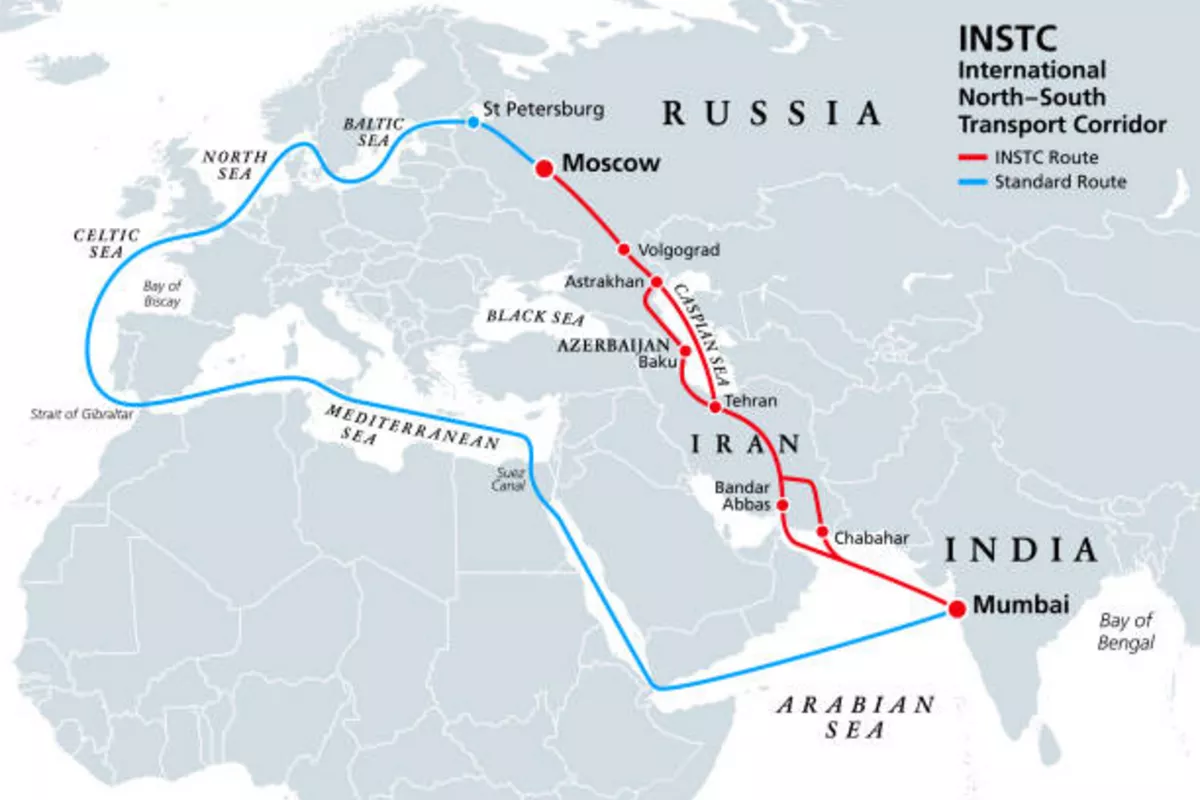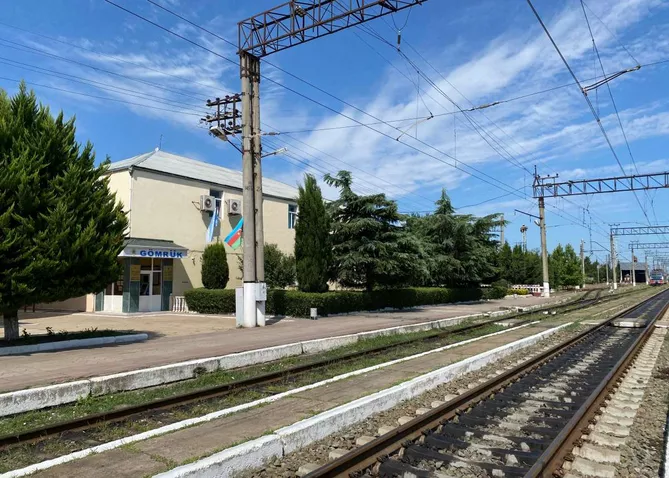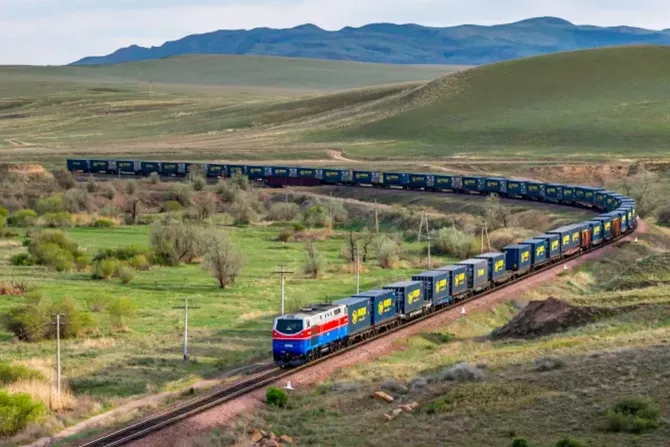
photo: Center for Eurasian Studies
On November 26-28, the 3rd Astrakhan International Forum, “International North-South Transport Corridor: New Opportunities and Horizons,” will take place. Launched in 2023, the event has already established itself as a reputable platform bringing together government officials, business representatives, and experts.
Ahead of the forum, news emerged that Moscow and Tehran are preparing to launch container transportation across the Caspian Sea next year. Shipments are expected to be routed to China and India.
The head of the Russian Federal Agency for Maritime and River Transport, Andrei Tarasenko, told journalists that container services along the Russia-Iran-India and Russia-Iran-China routes are planned to launch in 2026. Earlier negotiations were held between the Port of Makhachkala and the Iranian shipping company IRISL and its subsidiary KSSL.

photo: Reuters
A few days earlier, Iran and Russia agreed to establish the first joint maritime consortium aimed at strengthening trade, transport, and transit cooperation. The key objective of the consortium will be organizing maritime shipments across the Caspian Sea, including container traffic, and integrating the maritime segment into the International North-South Transport Corridor (INSTC).
The agreement was reached during talks in Makhachkala with participation from port authorities, major logistics companies, and government representatives from both countries, including Iran’s Deputy Minister of Transport and head of the Ports and Maritime Organization, Saeed Rasouli, and Russia’s Deputy Minister of Transport, Dmitry Zverev.
For now, no technical details about Caspian container shipping have been disclosed. It remains unclear what types of cargo, volumes, or container standards will be involved.
According to Russian experts, container shipping in the Caspian remains underdeveloped and ports lack adequate infrastructure. However, this applies specifically to the North-South route, where container logistics have not yet been operational.
Meanwhile, the Middle Corridor (Trans-Caspian International Transport Route) has been handling container shipments for years and continues to expand. Over the past several years, container traffic between the ports of Baku and Turkmenbashi has tripled, while volumes between Baku and Aktau are also increasing. In other words, along the East-West axis, the containerization challenge has largely been resolved, with the only remaining issue being port expansion in Azerbaijan, Kazakhstan, and Turkmenistan to meet rising demand.

photo: APA
The maritime segment of the INSTC has been operating for cargo transport for years, linking the Russian ports of Astrakhan, Olya, and Makhachkala with the Iranian ports of Amirabad, Anzali, and Nowshahr. Once reaching Iran, cargo is transferred to rail or road transport and sent south toward the Persian Gulf and further into the Indian Ocean. Despite maritime transport requiring lower investment than rail, both ends of the Caspian face bottlenecks - insufficient port capacity and vessel shortages.
Experts note that improving efficiency in the maritime segment of the corridor depends heavily on the launch of the Rasht-Astara railway, since rail access directly to port infrastructure would significantly increase throughput. Russia has recently intensified activities along the corridor.
According to Russian media, Russian Railways (RZD) has extended existing discounts for the transportation of a wide range of cargo along the corridor for another year, including via its western branch through Azerbaijan. Discounts of up to 50% will apply to certain export cargoes transiting the Samur border crossing onward to the Iran-Azerbaijan border crossing at Astara. Discounts of 20.4% will remain for export-import transportation in refrigerated containers to the Astara (Azerbaijan) station via Samur (and return routes). Transporters moving ferrous metals through Samur and then via the Beyuk-Kesik-Gardabani crossing on the Azerbaijan-Georgia border will also receive 50% tariff reductions.
These price incentives are intended to stimulate demand and competitiveness along the corridor. Similar tariff measures have also been applied to the eastern branch of the INSTC, running from Russia through Kazakhstan and Turkmenistan into Iran.

photo: Trend
In 2025, cargo flows along the North-South corridor demonstrated record growth, exceeding 8 million tons in the first nine months. Growth is primarily driven by the eastern route through Kazakhstan and Turkmenistan, where container traffic increased 1.7 times compared with the previous year, reaching 8.9 thousand TEU in the first 10 months of 2025. Work continues to expand the western branch through Azerbaijan, which could handle at least 5 million tons annually by 2028 if the Rasht-Astara railway is completed.
Construction of three new border checkpoints began in 2025 - Derbent, Verkhny Lars, and Yarag-Kazmalyar - along with major upgrades to the R-217 “Caucasus” highway segment of the corridor. Plans are also progressing for the “Arctic Railway Testing Ground” project, which would provide the North-South corridor with access to Arctic seaports.
Recently, rail service officially opened on the eastern branch of the corridor, running through Russia, Kazakhstan, Turkmenistan, and Iran. A freight train carrying 62 containers departed Moscow and proceeded along this route to Iran. From Iran’s Aprin dry port, shipments will either continue to China or travel to Bandar Abbas for onward transit to India.
Some Russian media outlets interpreted this development as a sign that Moscow was scaling back its reliance on the western route via Azerbaijan. However, Russia continues to support the Rasht-Astara project and expects construction to begin next spring once Iran completes land acquisition for the route.

photo: CNN
Following a trilateral meeting in Baku in mid-October involving government representatives from Azerbaijan, Russia, and Iran, Russian media reported that Iran adjusted the planned alignment of the Rasht-Astara section.
According to Deputy Transport Minister Nikolai Shestakov, these changes occurred during land allocation procedures and are standard practice for infrastructure projects. He noted that the adjustments would not affect overall project costs, although minor technical modifications may be required for bridges, overpasses, and other engineered structures.
Iran has exempted the project from taxes and fees. The total cost is estimated at €1.3 billion, and under the agreement between Moscow and Tehran, Russia will provide nearly 82% of the funding in the form of a state loan.
Despite the logistical and infrastructure challenges, experts agree that once the missing Iranian railway segment is operational, the western branch of the INSTC will become the most advantageous in terms of security, geography, and existing infrastructure availability, particularly thanks to Azerbaijan’s developed logistics ecosystem.
By Tural Heybatov
Share on social media